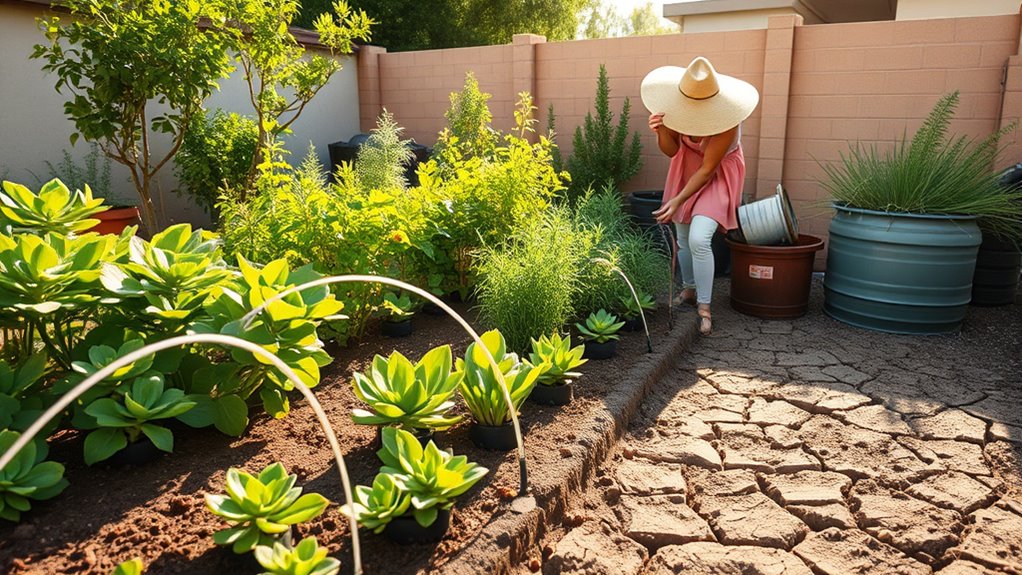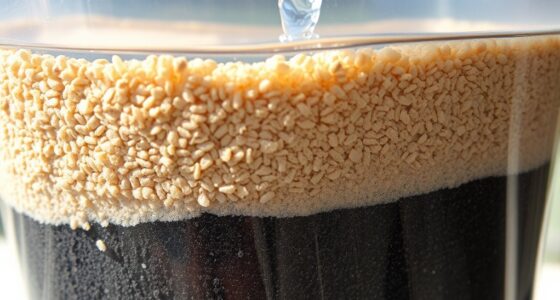To prepare for drought, you should focus on conserving water and selecting drought-tolerant plants. Fix leaks, install water-efficient fixtures, and water during cooler times to minimize evaporation. Choose native or drought-resistant plants that develop deep roots and thrive with less water. Mulching helps retain soil moisture, improving resilience. Combining these strategies makes your landscape more sustainable and better equipped to withstand dry spells—continue exploring to discover more ways to protect your garden effectively.
Key Takeaways
- Implement water-saving habits like fixing leaks and installing efficient fixtures to reduce overall water use.
- Choose drought-tolerant and native plants to enhance landscape resilience during dry periods.
- Water plants early morning or late evening to minimize evaporation and conserve moisture.
- Mulch around plants to retain soil moisture and decrease watering frequency.
- Incorporate strategic landscape planning that emphasizes drought-resistant plants and sustainable design.

Have you ever considered how prepared you are for a drought? It’s a question that might not cross your mind until the situation hits close to home. Droughts can strike unexpectedly, draining water supplies and stressing both your landscape and daily routines. That’s why practicing water conservation isn’t just about saving money; it’s about guaranteeing you have enough water when it’s most needed. By adopting simple yet effective water-saving habits, you can reduce your overall consumption and help stretch the supply during dry spells. Fix leaks promptly, install water-efficient fixtures, and water your plants early in the morning or late in the evening to minimize evaporation. These small actions add up and markedly decrease your water footprint.
But conserving water isn’t only about what you do during a drought; it’s also about preparing your plants to withstand dry conditions. Plant resilience plays a vital role in maintaining a healthy landscape with less water. Choosing drought-tolerant plants suited to your climate ensures your garden remains vibrant and healthy, even when water is scarce. These plants typically have deep root systems that access underground moisture, and many can withstand periods of drought without wilting or dying. Incorporate native plants, which have evolved to thrive in your region’s climate, making them naturally more resilient. Mulching around plants helps retain soil moisture, reducing the need for frequent watering. Gradually reducing watering over time also trains your plants to develop stronger root systems and adapt to drier conditions, boosting their resilience. Additionally, hackathons can be a great way to gather innovative ideas and solutions for sustainable gardening and water conservation projects.
Preparing for drought isn’t just about individual efforts; it’s a mindset that combines water conservation with strategic landscape planning. By integrating drought-resistant plants into your yard, you decrease your reliance on supplemental watering, saving water and money. When you prioritize plant resilience, you make your landscape more sustainable and less vulnerable to the impacts of prolonged dry spells. This approach not only helps your plants survive and thrive but also reduces your overall water usage, easing the strain on local water resources.
In the end, being prepared for a drought involves proactive measures. Water conservation habits save resources and money, while planting resilient species strengthens your landscape’s ability to endure dry periods. Both strategies work together to create a more sustainable environment, ensuring that you and your plants can withstand the challenges of drought. Taking these steps now will make your landscape more adaptable and your water supply more secure, giving you peace of mind when dry conditions persist.
Frequently Asked Questions
How Can I Identify Early Signs of Drought Stress in My Plants?
You can spot early signs of drought stress in your plants by looking for symptoms like wilting, leaf curling, and browning edges. These early plant warning signs indicate they’re not getting enough water. Pay attention to reduced growth and dry soil around the roots. Recognizing drought stress symptoms early helps you act quickly, such as watering deeply or mulching, to protect your plants and prevent further damage.
What Are the Best Drought-Tolerant Plants for My Region?
You should choose native species that thrive in your region’s climate, ensuring they require less water and care. Incorporate xeriscape principles by designing your landscape with drought-tolerant plants like succulents, lavender, or sedum, which survive dry conditions. These plants not only reduce your water use but also create a resilient garden. By selecting the right native and drought-resistant plants, you’ll save water and maintain a healthy landscape during droughts.
How Often Should I Water During a Drought to Conserve Resources?
Like a wise sage tending a delicate flame, you should water deeply but infrequently during a drought. Aim for a watering schedule that allows the soil to dry out between sessions, typically once every one to two weeks, depending on your area’s conditions. Use water conservation techniques like mulching and drip irrigation to maximize efficiency. This approach helps your plants thrive while conserving resources and respecting nature’s balance.
Are There Specific Soil Amendments That Improve Water Retention?
You should use soil amendments like compost, peat moss, or vermiculite to improve water retention. These amendments boost your soil’s ability to hold moisture, reducing how often you need to water during a drought. Incorporate them into your soil before planting or mix them into existing beds. Doing so helps your plants stay healthy longer, conserves water, and makes watering more efficient during dry periods.
How Can I Create a Drought-Resistant Landscape Design?
Ironically, designing a drought-resistant landscape is easier than you might think. Focus on xeriscaping principles, which emphasize minimal water use, and select native plants that thrive with less water. Arrange your yard to reduce runoff and evaporation, incorporate drought-tolerant ground covers, and use mulches to retain soil moisture. This approach not only conserves water but also creates a sustainable, beautiful space that withstands drought conditions effortlessly.
Conclusion
By taking proactive steps today, you become a guardian of your garden’s future, turning drought from a looming threat into a manageable challenge. Think of your efforts as planting seeds of resilience—each drop of water saved and plant protected is a victory in your personal climate battle. Remember, just as a single spark can ignite a wildfire, your small actions can spark a big change, ensuring your plants thrive even in tough times.










